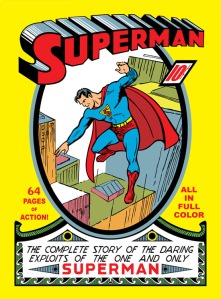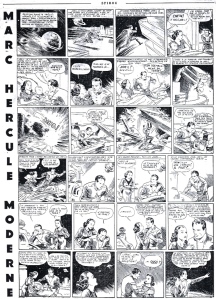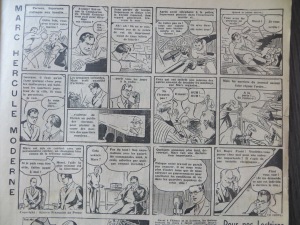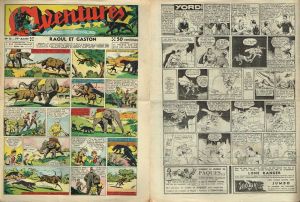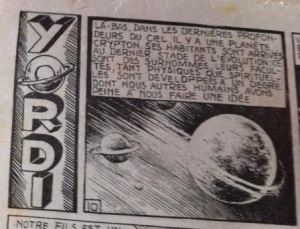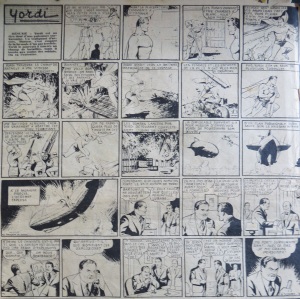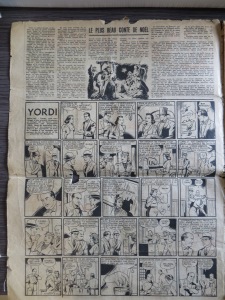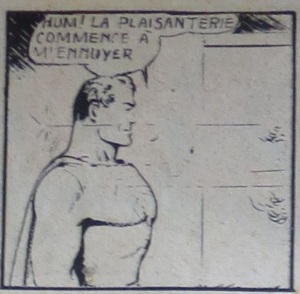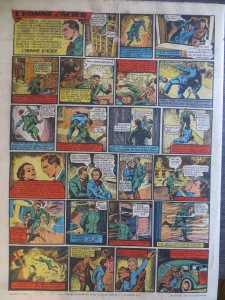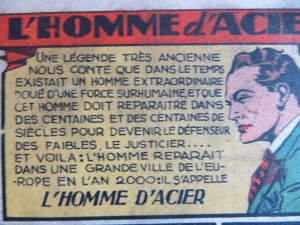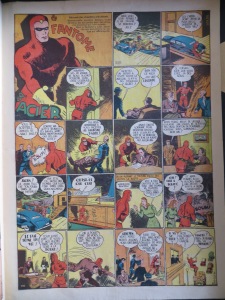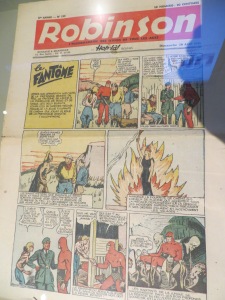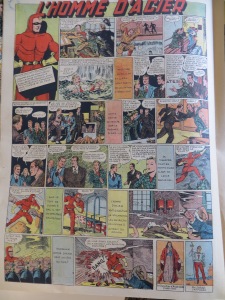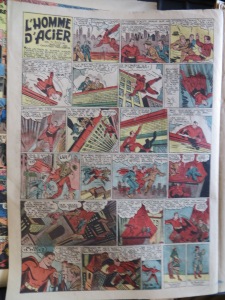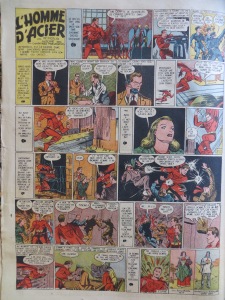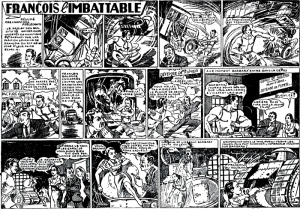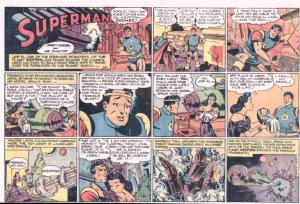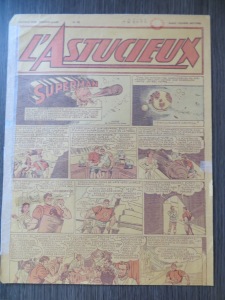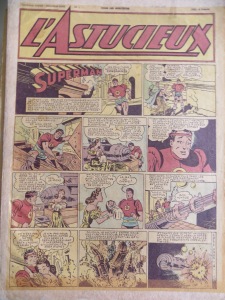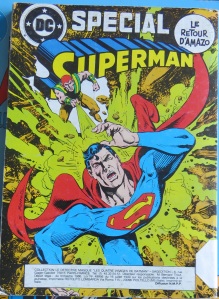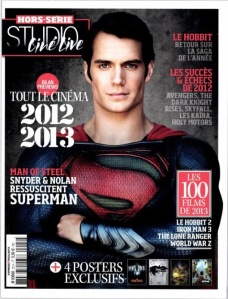March 1939 was a good month for Superman. Less than a year after his debut, Action Comics No. 11 was flying off newsstands, his daily comic strip was starting its third month of syndication, and Superman No. 1, his first solo comic book, was in production.
March is also the year the Man of Steel landed in Europe. Clark’s French pronunciation wasn’t very good though, so the Belgian weekly periodical Spirou must have thought he said his name was “Marc.” Spirou had already introduced Dick Tracy to their readers, and on March 2, they added Superman’s daily newspaper strips in batches of six under the side banner “Marc Hercule Moderne”:
Their translators also switched Kent to Costa, Lois to Jenny, and the Daily Star to the Evening News. The comic book center in Angouleme has this 3-strip installment from the January 2, 1941 issue:
Spirou stopped running the feature later that year. The cancellation isn’t surprising, considering Germany invaded Belgium in May 1940. The occupation ended in 1945, the year Superman returned to Spirou. Belgium deported him again in 1947, due, I presume, to anti-American censorship sweeping French-language comics in the late 40s.
But back in March 1939, France was happy to stamp Superman’s passport. Five days after Marc the Modern Hercules landed in Belgium, those same daily strips premiered in the French weekly tabloid Aventures:
That editor misheard his name too:
Spirou sometimes called him the Man of Steel (le Homme de Acier) or the Superman, within panels, but Aventures was owned by an anti-fascist Italian who had fled Mussolini’s dictatorship; he wasn’t about to print a name associated with Nietzsche’s ubermensch. Plus he thought the exotic-sounding “Yordi” better suited a guy from another planet.
Aventures didn’t like Superman’s American newspaper strip’s layout either. Joe Shuster was drawing four, doggedly square panels a day:
Aventures preferred five. So, back in the Angouleme stacks, you can see the No. 30 issue from July 25, 1939 collects six of the dailies published in the U.S. from May and June, but with the panels rearranged and shrunk to accommodate a five-panel width:
The layout team kept it up. No. 51, from Dec 19, 1939, rearranges six dailies from November and December:
According to at least one account they removed the “S” on Yordi’s chest too, though another source states otherwise. My own eyeball analysis is inconclusive. I’m not sure if I’m looking at a lightly erased chest emblem, or just time-faded newspaper ink:
Either way, Yordi’s fans found better things to worry about when the series halted after the German invasion.
The occupation didn’t end the Man of Steel’s residency in France though. Starting on October 27, 1940, the fifth issue of Les Grandes Aventures introduced “Le Homme de Acier” on their color back page:
Les Grandes Aventures was also running a doctored version of Batman, “Le Justicier,” loosely redrawn from Bob Kane’s Detective Comics art, but their Man of Steel is something different. The art and stories aren’t Shuster and Siegel’s:
Based on my mastery of Google Translate and my daughter’s high school French III, that opening panel reads something like:
“A very ancient legend tells us that once there was an extraordinary man gifted with superhuman strength, and that this man must reappear in hundreds and hundreds of centuries and become the defender of the weak, the administrator of justice . . . and here it is: The man reappears in a large city of Europe in the year 2000. He is called the Man of Steel.”
Although he is invulnerable to fire (“au feu”) and begins his career by catching his Lois Lane (“the girl that is named Marise”) after villains toss her from a skyscraper window, this Homme de Acier sports a red tie and green vest, a far cry from the cape and leotard of his American brother.
Things get even stranger over at Hurrah! in 1941. The Blue Beetle was appearing as the red-costumed “Le Fantome d’Acier” (The Phantom of Steel):
The Beetle’s altered look and name was due in part to the popularity of Lee Falk’s Phantom strip. The French periodical Robinson had probably swapped the purple costume for a red one because the ink was cheaper:
But back at Hurrah!, “Le Fantome d’Acier” transforms into “L’Homme d’Acier” on November 5, 1941 (No. 311):
The Beetle-derived costume is the same at first, but then L’Homme d’Acier starts sporting the cape and briefs of the actual Man of Steel, minus his “S” emblem:
Things are stranger still at Editions Mondailes with the arrival of “Francois L’Imbattable” (the Unbeatable):
This Francois episode is redrawn from three of Superman’s May 1940 daily strips, but with each panel reversed:

Superman, or “Surhomme,” also appeared in the doctored form of Bill Everett’s Amazing-Man.
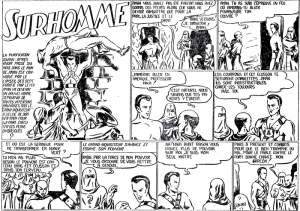
France doesn’t receive a completely unaltered Superman until well after the war, when the new tabloid L’Astucieux begins reprinting Wayne Boring’s Sunday newspaper pages from November 1944:
L’Astucieux launched itself and baby Superman from Krypton with an introductory four-page issue numbered “00” on May 14, 1947. Angouleme’s copy is badly faded:
No. 1 is eight pages and in slightly better shape:
No. 1 also includes Batman (renamed red wings, “les ailes rouges), but that’s another story. This “Crafty” (how Google translates “austuciex”) Superman, like his twin “Marc” who was running simultaneously in Spirou again, didn’t last long in the post-war wave of comic book censorship.
When the Man of Steel returned in the 70s, he was published by Sagedition, formerly known as Sage, the publisher of the long defunct Aventures. This time they didn’t change his name to Yordi. The Angouleme collection includes one of Superman’s final, 1986 adventures, published months before Sagedition went under:
But don’t worry, Francophiles. France is still receiving heavy doses of Homme d’Acier. Only no one bothers to translate his name into French anymore:

